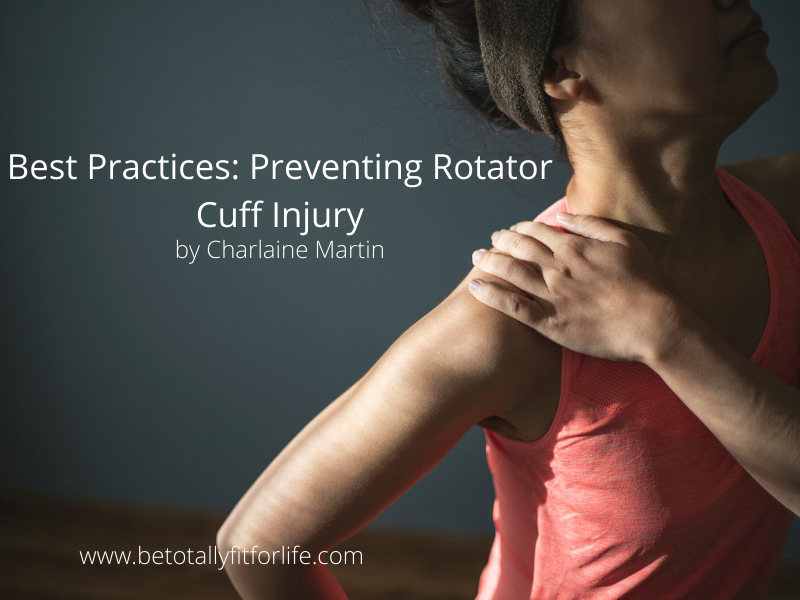Best Practices: Preventing Rotator Cuff Injury

Anytime we make a joint work beyond its normal range of motion, it becomes vulnerable to damage. For example, the weight of the microwave and box pulling my Boaz’s arm back and outward while he held it on his shoulder took it out of its natural range of motion, causing sheer force damage. Likewise, lifting too much weight overhead, pushing something resistant to move with great force, and many other movements can tear these essential muscles and tendons. Prevent injury from the very start of your exercise with this critical muscle group.
My Boaz had rotator cuff surgery recently and is recovering. It happened because he was carrying a microwave in a box down a 12 ft. ladder, and it slipped backward, jerking his arm down and slightly sideways. He was in extreme pain, but because one doctor told him it was just a strain, he pushed through the pain to get projects done so we could pass our home inspection. Unfortunately, the pain never subsided, so I encouraged him to get a second opinion two months later. Guess what? He had several nasty muscle and tendon tears, with one muscle tendon completely separated from the bone. Now he is going through physical therapy, but it will take at least six months to heal. So I thought it a good idea to discuss the rotator cuff with you, so you know what it is, what it does, and how to avoid damaging yours.
The rotator cuff is often mistaken for a cup of cartilage around the end of the humerus bone at the shoulder joint. Instead, it is a group of four small muscles that attach at the four “corners” of the shoulder joint underneath the major muscles: deltoid, pectorals, trapezius, bicep, and tricep. They use the acronym S.I.T.S.—supraspinatus, infraspinatus, teres minor, and subscapularis. These four muscles work together to stabilize the shoulder joint allowing the complex joint to move in a wide range of motion. As the name implies, this team of muscles performs rotational motion in all the planes of movement. However, due to the complexity of the shoulder joint and its range of movement, you can easily damage these muscles (Johns Hopkins).
My husband could feel a lot of pain simply by using a screwdriver. We open doors using them, open and close jar lids, and reach up and pull down items on shelves. They also aid in raising the arm to wash and comb your hair and use a curling iron or hair straightener. We are usually unaware of how they work until they don’t. God’s incredible, complex joint design allows us to do so many things with our arms.
With the damage he sustained, his shoulder became very unstable. It felt like it would slightly dislocate at times. Probably, because he worked for a couple of months with torn muscles, the instability aided tears on the edge of the cartilage on the head of the humerus bone. This kind of damage doesn’t heal on its own but requires surgery.
Several activities can overwork and strain the rotator cuff muscles. For example, activities like swimming with repetitive overhead movements, tennis with unpredictable swings to hit the ball from several directions, and heavy weight lifting like the overhead and bench press put the rotator cuff muscles at risk of damage. Also, these activities can put the rotator cuff at risk: boxing, martial arts, kayaking, baseball, softball pitches, bat swings, and bowling.
According to Livestrong.com, here are some exercises to avoid, with recommended replacements:
Overhead Pulldown behind the head—replace with Front Lat Pulldown
Scaption (Upright rows)—replace with Seated Dumbell Shoulder Press
Palm up lateral raise, or thumb down lateral raise and release—Keep your hands palms down with the thumbs facing forward, lifting to level with shoulders and never above the shoulder.
Behind the neck shoulder press—front shoulder press.
If you’ve damaged your rotator cuff in the past, avoid these exercises as well and use the recommended replacement exercises instead:
Battle Ropes—Try the Farmer’s Walk carrying kettlebells like water buckets.
Tricep Dip— skull crushers (forward two hand tricep press)
Also, if you do PraiseMoves, moving from the Tent posture, rotating with one hand on the floor with the other hand over your head, face-up can put your shoulder at risk for reinjury. It is an advanced posture! Work through the primaries and follow the instructor’s recommendations before attempting this posture. You can find this exercise on the Power PraiseMoves DVD.
Another potential hazard I learned about as a water exercise instructor at the YMCA is hanging on the pool’s edge with your arms on the deck or gutter, facing toward the water. Tricep dips from the deck, repeatedly dipping into the water, putting people at risk of shoulder impingement.
A third way I learned from my training as a Kettlebell Instructor is that you can damage the rotator cuff is the improper execution of some kettlebell exercises. The ones to be sure you do correctly are:
Clean and Press—keep the elbow in as you rotate from the floor before pressing upward.
Kettlebell Swings—never swing high. Always swing to shoulder level, no higher.
Circling your head—circle tight to your head about eye level.
God’s unique design of the human shoulder allows us to do complex movements, making it imperative that we protect the rotator cuff by avoiding specific exercises known to cause damage. Doing the preliminary work before moving on to advanced exercises, and executing exercises properly can make a huge difference.
Many blessings to you!
